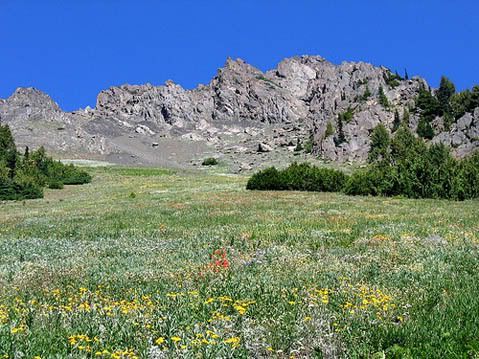Accord Reached in Buckhorn Gold Mine Controversy

Buckhold Mountain in Late Spring
Introduction:
This article, describing a break through among conservation groups and mining interests, show what is possible through strong leadership and creative risk taking. ~ Marc
Tonasket, WA – An accord was reached between conservation groups and mining interests, ending an 18-year effort to stop the development of a large gold mine on Buckhorn Mountain in north central Washington State. By negotiating the agreement signed by both mining opponents and the company that will build the mine, Okanogan Highlands Alliance (OHA) was able to achieve proactive environmental protections beyond those required by federal and state agencies.
In September 2006, the Washington State Department of Ecology approved a permit for Crown Resources/Kinross to construct the proposed mine which OHA appealed. Over a year later in the fall of 2007 the Department issued water rights and water quality certification which were appealed by OHA, Washington Environmental Council (WEC), and the Center for Environmental Law & Policy(CELP). These and other permit appeals were consolidated and the parties were preparing for a trial scheduled to begin on May 12. With the signing of the agreement, the groups withdraw the appeals in exchange for verifiable, independent monitoring and increased mitigation.
“The groups realized we could win more by settling.” stated David Kliegman, OHA’s Executive Director, who has led the fight against the mine for nearly two decades. “Instead of a very expensive legal battle, OHA and Crown will put our resources into positive improvements for our community and the environment and independent oversight of the mine impacts.”
Despite significant changes to the rejected proposed open-pit mine from the 1990s, grave concerns remain about the current underground mine proposal. The settlement allows the parties to track these concerns and minimize the impacts of the mine.
Key parts of the settlement with Crown focus on improved monitoring and mitigation. High-points include: maintenance of the natural water levels for headwater creeks on Buckhorn Mountain; protection for residents worried about their wells; additional wetland and stream improvement projects in the Okanogan Highlands; and third party monitoring with independent verification and annual audits of monitoring results.
“OHA believes this settlement is a victory and will be looked at as a win-win for the local community.” added Kliegman. “We aren’t going anywhere. We will continue to keep a close eye on this mine’s operations for a very long time.”
With the settlement, the mine will provide jobs to the area and the local community can have a reasonable level of confidence that the mine will not be detrimental to the environment.
“We applaud OHA’s work and are supportive of the settlement because it takes a long-term view of the impacts from the mine and assures accountability from the mining company to minimize those impacts on the mountain, the creeks and local people,” said Joan Crooks, executive director of Washington Environmental Council.
“The public interest is protected in this settlement. Water impacts have been a contentious issue for more than ten years and we are glad to finally get it right,” said Rachael Paschal Osborn, executive director, Center for Environmental Law & Policy.
The details of the agreement focus on monitoring and mitigation.
Key Monitoring Provisions:
Key Mitigation Provisions:
OHA and Crown previously worked out an initial settlement of issues regarding road access through federal lands, with an agreement for third party independent monitoring and oversight of water quality in Marias Creek where 100 trucks a day would transport ore to the mill near Republic, WA. This separate agreement is anticipated to be signed in the near future.
+++++++++++++++++++++++++++++++++++++++++++++++++++++++++++++++++++
A very brief history of the last two decades: OHA’s efforts to protect the Okanogan Highlands from the impacts of large scale mining has put it in the regional and national spotlight. OHA was organized in 1992. WEC and others were able to expose the need for comprehensive mining reform and helped negotiate the state Metals Mining and Milling Act of 1994.
The Colville Confederated Tribes banned mining on the Reservation in 1995. Beginning with federal approval in 1997, the open pit mine proposal was on track with the Department of Ecology approval of water right and water quality certification.
Then federal agencies shocked the country by denying the Plan of Operations and revoked the Record of Decision based on a little known provision of the 1872 Mining Law limiting the amount of Millsites per Mining Claim. Then US Senator Slade Gorton exempted the proposed open-pit mine from federal law with an attached rider to the Kosovo appropriations bill, putting the proposed mine back on track.
Then the State Pollution Control Hearings Board, after hearing arguments from OHA, WEC & CELP, unequivocally rescinded and revoked the Department of Ecology permits in January of 2000. That action essentially stopped the open-pit mine proposal. A more complete timeline can be found at: http://www.okanoganhighlands.org/about/timeline
Okanogan Highlands Alliance is a non-profit organization that is dedicated to educating the public about the environmental threats of large-scale mining. Washington Environmental Council has worked for 40 years as a leading voice in the state for the protection of our land, air and water. Center for Environmental Law & Policy serves as a voice for the public interest in water resource management and preservation in Washington State.
More information can be found at: www.okanoganhighlands.org and www.celp.org
